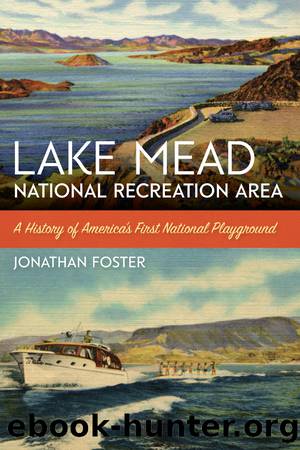Lake Mead National Recreation Area by Foster Jonathan;

Author:Foster, Jonathan; [Foster, Jonathan]
Language: eng
Format: epub
Publisher: University of Nevada Press
CHAPTER FOUR
Balancing Act
Recreation and Modern Challenges at Lake Mead National Recreation Area, 1967â2000
In the twentieth centuryâs latter decades, LMNRA faced a more difficult existence than it had during its first thirty years, for many of the problems inherent to NPS management of reservoir-based recreation became evident. Despite the improved amenities made possible by Mission 66, area officials faced ever-more difficult challenges in meeting the recreation-first mandate laid out by the governmentâs NRA criteria of 1963. The NPSâs management role grew exceedingly difficult as the publicâs expectations of free, safe, and unregulated recreation ran up against increased crime and accident rates and the conflicting needs of various factions of recreationists, environmentalists, and administrators. This required the NPS and LMNRA administrators to exercise their power of regulation over park activities and accessibility more regularly. Thus, public anxiety mounted as the image of LMNRA and its visitorsâ experience began to suffer.
In 1967, one year after the Mission 66 programâs conclusion, LMNRA hosted 4,102,300 visitors. This statistic indicates an astounding increase in visitation over the recreation areaâs first thirty years. In 1937, after all, only 389,294 people had visited the newly created recreation area. Though usage increased dramatically during the areaâs first thirty years of existence, visitation growth over the next thirty years was even more impressive. In 1997, the area admitted some 8.5 million people. This number, nonetheless, was approximately 1.3 million fewer than the 9.8 million who visited in the most popular year of 1995.1
The popularity of LMNRA during this era is further underscored by its visitation rankings relative to other NPS units. Over an eleven-year span, from 1989 to 2000, the recreation area ranked in the top five of all NPS units in terms of annual visitation. For four of these years, including the peak year of 1995, LMNRA ranked third.2
Such popularity was a doubled-edged sword. Along with accolades for success in attracting visitors, busy administrators and staff often had to deal with inadequate funding and visitation-related problems. Specifically, the NPS and recreation area officials had to provide a safe and accessible setting for an overwhelming flood tide of recreationists, while attempting to preserve the areaâs unique environment and cultural resources. Navigation of this difficult path often led to tension between competing groups regarding access, regulation, and environmental degradation.
An incident in Yosemite National Park on July 4, 1970, served as a harbinger of the issues to be faced by the NPS and LMNRA during this period. That day, a gathering of some 500 counterculture youths rioted at the parkâs Stoneman Meadow. Provoked by the attempted arrest of one of their own, youths battled park rangers with rocks and bottles, ransacked campsites, and overturned automobiles. Reports also alleged that rangers opened fire with shotguns before being driven off by the rioters. Rangers returned with reinforcements and regained control of the area the next day. The battle resulted in ninety arrests on charges of drunk and disorderly and minors in possession of alcohol. Approximately thirty rioters and five rangers received medical treatment for injuries.
Download
This site does not store any files on its server. We only index and link to content provided by other sites. Please contact the content providers to delete copyright contents if any and email us, we'll remove relevant links or contents immediately.
| Air Travel | Bed & Breakfasts |
| Cruises | Dining |
| Hotels & Inns | Parks & Campgrounds |
| Railroad Travel | Road Travel |
Good by S. Walden(3346)
A Short History of Nearly Everything by Bryson Bill(2508)
Claridge's: The Cookbook by Nail Martyn & Erickson Meredith(2257)
Hidden Valley Road by Robert Kolker(2114)
On Trails by Robert Moor(1793)
Rick Steves London 2018 by Rick Steves & Gene Openshaw(1751)
Deep South by Paul Theroux(1717)
KITCHEN CONFIDENTIAL Adventures in the Culinary Underbelly by Anthony Bourdain(1699)
The Art of Flight by unknow(1692)
Blue Highways by William Least Heat-Moon(1662)
Trans-Siberian Railway by Lonely Planet(1629)
1,000 Places to See in the United States and Canada Before You Die (1,000 Places to See in the United States & Canada Before You) by Patricia Schultz(1553)
Long Bright River by Liz Moore(1490)
Ticket to Ride by Tom Chesshyre(1479)
Flight by Elephant(1418)
The Great Railway Bazaar: By Train Through Asia by Paul Theroux(1397)
BBQ Joints by David Gelin(1372)
The Old Patagonian Express: By Train Through the Americas by Paul Theroux(1293)
Practice Makes Perfect by Gilda Nissenberg(1261)
